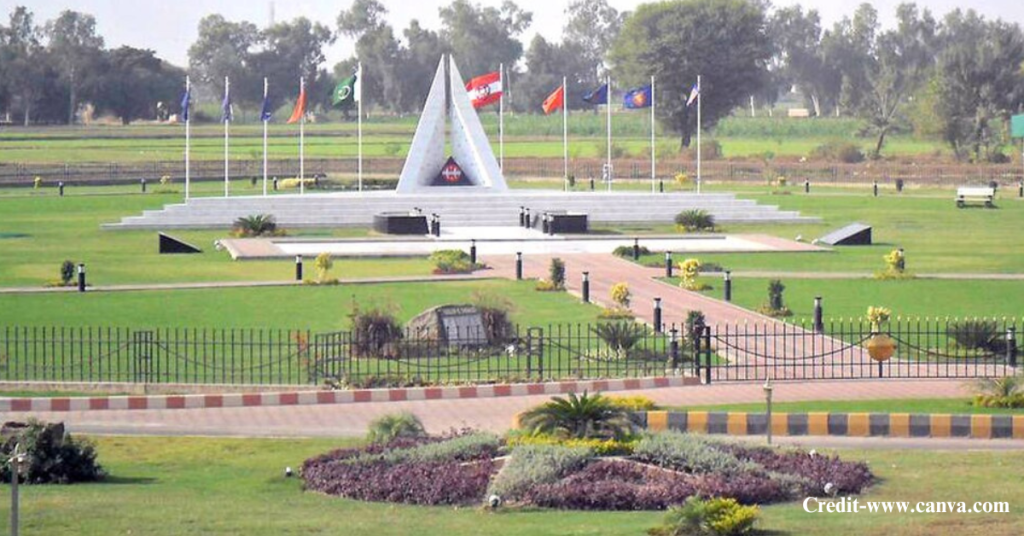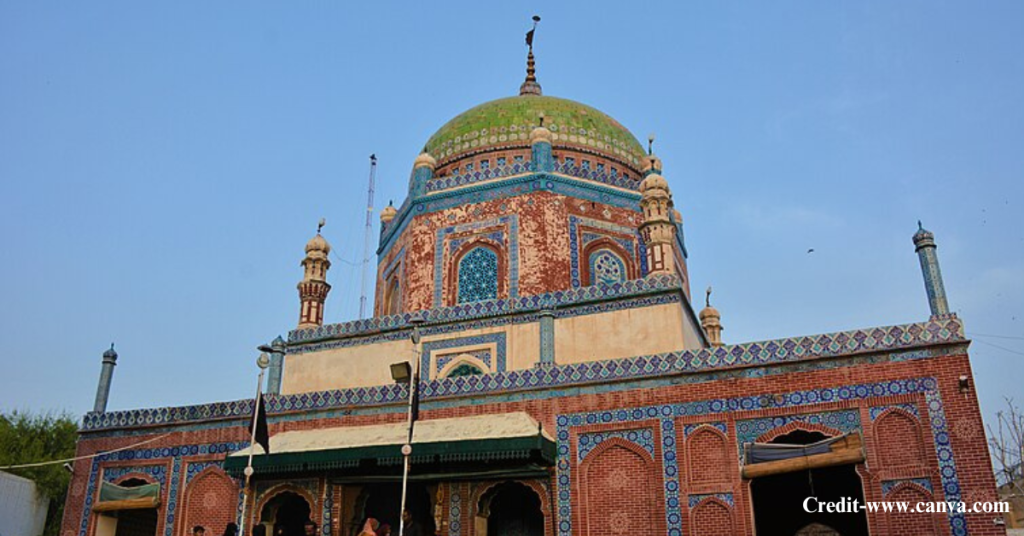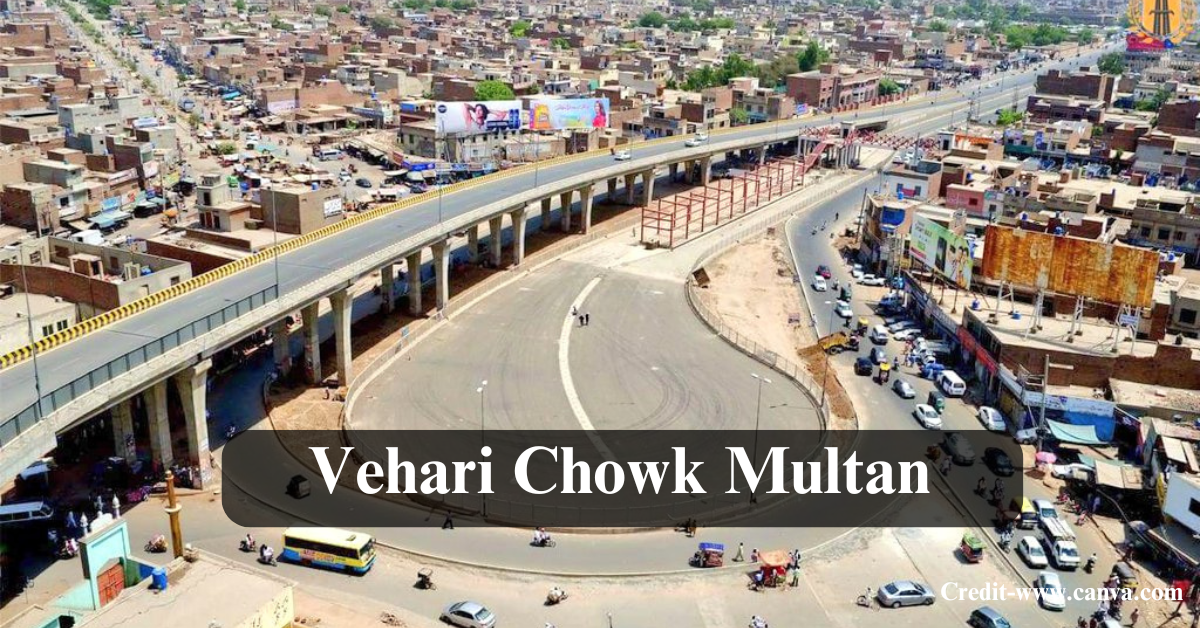Vehari Chowk is a roundabout in Multan. Much traffic passes through it. The place has noise, many people, and activity. Buses sound their horns, rickshaws force their way through cars, and sellers call out prices; they cook parathas on metal plates.
A person might look for a bus to Bahawalpur. Soon after, they bargain over the cost of a used cooler or a spare tire. If a person lives in Multan or just drives through it, Vehari Chowk has likely changed their day.
A student travels to college, or a shopkeeper opens his store. Someone tries to buy breakfast. This person might lose a shoe in traffic. Vehari Chowk is part of their daily life.
Table of Contents

Why Vehari Chowk Multan Matters
Vehari Chowk serves thousands of people daily – it joins many city sections and also reaches out of town. The chowk sits on Multan-Vehari Road and connects with other large roads, such as Khanewal Road, in addition to Bosan Road. It also links easily to the N-5 National Highway.
The place matters for several reasons.
- It moves commuters from southern Multan to essential locations like Gulgasht and Bahawalpur Chowk, along with inner Multan.
- Trade and travel pass through here, as trucks, vans, buses, as well as bikes, all move on its roads.
- It draws customers for all sorts of roadside businesses.
The chowk serves as a community place. Tea stalls, mosques along with repair shops are there. Local events happen often.
Vehari Chowk is not just a road – it is a large part of daily life for local people, shopkeepers, students as well as travelers.
Where It Sits – Location & Connection
You’ll find Vehari Chowk right where Multan starts stretching out south. It connects:
- Multan–Vehari Road
- Bosan Road
- Khanewal Road
- Near routes to the National Highway (N-5)
The building sits in the middle but also faces out. From here, people start trips to Bahawalpur, Khanewal, Vehari, or Karachi.
The area is central and faces outward. This position helps people start trips to Bahawalpur, Khanewal, Vehari, or Karachi.
For quick rides, Careem, InDrive, Qingqi, along with rickshaws, work without stopping near here. If you travel outside the city, the Faisal Movers’ terminal is closed – this helps you book a bus with 30 minutes’ notice.
People from Fatima Jinnah Town, Lodhi Colony, Sadiqabad Colony, as well as Gulshan-e-Yousaf use this path to reach their workplaces, schools, markets, in addition to their family homes.
Transport: What Rolls Through Vehari Chowk?
This is where things get wild.
Vehari Chowk sees just about every vehicle Pakistan has:
- Passenger buses (Faisal Movers, Skyways)
- Local vans and Suzuki pickups
- Qingqis, rickshaws, and Careem rides
- Bike riders weaving like it’s Need for Speed
- Even donkey carts carrying vegetables
Need to send money or load your mobile before a trip? JazzCash and Easypaisa kiosks are everywhere, so you’re sorted in minutes.
No actual bus terminal stands here. That lack increases disorder. People wait near the road. Sellers mingle with people going places. Drivers try to pass each other, like they are in a race to no particular finish. The system functions. And if you’ve lived here long enough, you know exactly where to stand to catch your van without getting crushed.
Vehari Chowk’s Market: A Maze of Local Trade
Vehari Chowk Market is the kind of place where you go looking for a fan remote and end up with samosas, socks, and a new SIM card.
It’s loud. It’s packed. It’s everything a local market should be.
Here’s what you’ll find:
- Tyre shops & auto repair stalls
- Mobile accessories kiosks
- Street-side tailors and barbers
- Battery, light, and spare part sellers
- Fresh fruit & snacks from carts
Small shops for clothes, small food stores, and local markets operate in this area. Allied Bank, in addition to Faysal Bank, maintain offices here. This allows residents to conduct their banking tasks. Gas stations are also open; they provide fuel for motorcycles, rickshaws, and vans.
If you look for a fan part, a phone card, or a cold drink, you will find it.
Food Scene: What to Eat at Vehari Chowk
If you’re hungry, you’re in the right place.
The food at Vehari Chowk is basic but full of flavour. The kind that hits different when you’re standing under the sun with dust in your shoes.
Here’s what people are eating:
- Halwa puri with aloo tarkari and pickle in the mornings
- Bun kebabs with spicy chutney grilled while you wait
- Fried samosas, pakoras, and jalebi in the evenings
- Chai from kettles that never rest
- Roadside daal, chana, or biryani for a quick lunch
Local dhabas offer cheap, hot meals that are perfect for truck drivers, mechanics, and office workers grabbing a bite on the go.
You might come for car repairs—but you’ll stay for the samosa.
Living Around Vehari Chowk – Residential Side
You wouldn’t think so with all the traffic and business noise, but there’s a lot of residential life around Vehari Chowk. These areas are just a few minutes away:
- Fatima Jinnah Town – Known for newer houses and planned streets
- Lodhi Colony – Mixed housing with rental and owned options
- Sadiqabad Colony & Gulshan-e-Yousaf – Older areas, closer to the chowk
- MDA-approved blocks near Vehari Road
Property here is getting attention, especially for small investors and people looking to buy on a budget.
A 3-marla house was recently listed at PKR 45–50 lakh, while 5-marla homes in side lanes go higher. Rent is also rising due to commercial activity.
With more roads being built and better connections, this area is slowly changing—and real estate buyers know it.
Traffic, Road Condition & Safety Concerns
Let’s be honest—Vehari Chowk is not an easy ride.
- Rickshaws stop anywhere
- Vans block the lanes
- Motorbikes cut in every few seconds
- People cross roads like they’re in an action movie
A Loksujag report said that from 2019 to 2023, there were over 5,000 road accidents on Multan–Vehari Road—74 of them were deadly.
This is more than just a traffic jam—it’s a real safety issue.
The good news?
A dualisation project is underway, thanks to public-private efforts. Once finished, it should:
- Separate traffic flow more clearly
- Make crossings safer for pedestrians
- Ease pressure on main routes
But until then, keep your eyes open and your foot ready to brake.
Real People, Real Stories
Hassan, a college student, rides through here daily:
“If I leave at 7:45, I will reach college in 25 minutes. But 8:00? I’m stuck in traffic till 8:50.”
Mrs. Shaheen, a local tailor near the chowk, says:
“Business is good, but customers always complain about no parking. One time, a van blocked my door for two hours!”
It’s these everyday stories that show Vehari Chowk isn’t just a traffic stop—it’s a slice of life in Multan.
Culture & Community Buzz
Vehari Chowk feels like a city inside a city.
- Loudspeaker calls from masjids
- Vendors calling out fruit prices
- Children chasing tyres between moving rickshaws
- Workers sitting on footpaths sharing chai and gossip
Sometimes there’s a political speech. Other times, it’s just an uncle passionately arguing about electricity bills. Either way, it’s alive and full of stories.
What’s Next for Vehari Chowk?
The Multan Development Authority (MDA) is finally looking this way. Ongoing and planned projects include:
- Road widening and dualisation
- Flyover and underpass planning
- Signal setups to reduce mess
- Possible rezoning for better commercial use
This means property rates could rise, and traffic might become less insane (fingers crossed).
FAQs
Q: Why is Vehari Chowk important?
A: It’s a significant point for trade, transport, and daily life in Multan.
Q: Is it safe?
A: It’s busy and risky for pedestrians, but road projects aim to make it safer.
Q: What can you buy here?
A: Everything—tyres, samosas, SIM cards, fan parts, and mobile repairs.
Q: Are there places to live nearby?
A: Yes, several areas have houses and flats for rent and sale.
Q: What kind of food is famous here?
A: Halwa puri, bun kebabs, chai, and samosas are top picks.

Final Thoughts
Vehari Chowk appears plain – it lacks beauty. The place represents Multan completely. It has noise, warmth, many tales, and constant movement.
Commerce meets travel there. Tea drinkers talk. Everyone has a place to go. From people buying land to those riding buses, and from tea stalls to tire stores, this junction connects the city.
The next time you go through Vehari Chowk, do not just continue your journey. Halt. Observe the surroundings. Pick up a snack. See how the city functions.
You will depart with a story, and likely a samosa in your hand.

